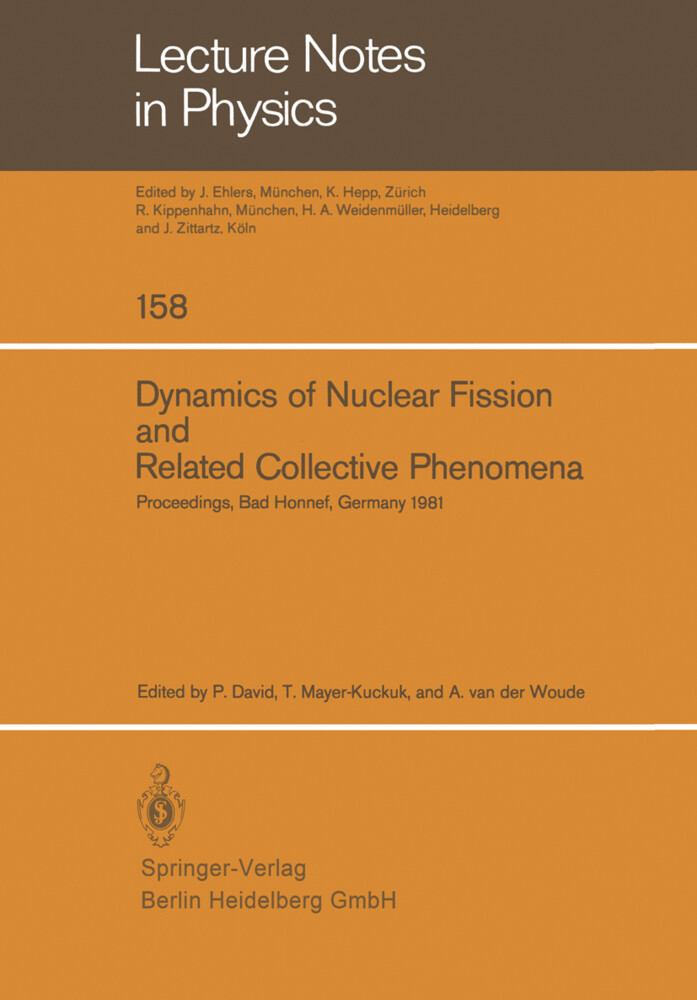Cold rearrangement of nucleons in fission and fusion.- Fast and slow fission.- Cold fragmentation of 234U and 236U.- A combinatorial analysis of pair-breaking in fission.- Muon-induced fission.- Study of muon-induced fission with the photoemulsion-method.- Self-consistent microscopic description of fission the scission mechanism.- The lowest ?-vibrational phonon in the second minimum of 236,238U.- 232Th fission barrier characteristics from the 232Th (p,p?f) reaction.- 232Th subthreshold photofission angular distributions.- Asymmetrically deformed states of 231,233Th during the fission process.- High resolution energy measurement in (d,pf) reactions.- Angular distribution and total kinetic energy for 232Th(n,f).- Study of energy dissipation in 234U fission from the 233U(d,pf) reaction.- Structure of the mass distribution of the fission fragments of 3He induced fission of 169Tm.- The cosi fan tutte project.- Entrance channel properties of (d,pf) reactions on 232TH and 238U.- Energy dissipation / Nuclear shell effects in fission.- Pair excitations in low energy fission.- On the semiclassical description of adiabatic nuclear motion.- Identification of a shape isomeric band in 32S.- Spin-isospin modes in electron scattering and charge exchange reactions.- Distribution of the isoscalar giant quadrupole resonance strength in 208Pb.- Splitting and broadening of giant resonances in uranium due to deformation.- Fission decay as a measure of statistical equilibration of coherent collective modes.- Excitation and fission decay of new isoscalar giant resonances.- Investigation of the fission decay of the GQR in 238U by e?- and e+-induced fission, and tests of DWBA virtual photon spectra.- Study of the E2 strength distribution in 238U by (e,e?f) coincidence experiments.- Decayof the giant quadrupole resonance region in 208Pb.- Experimental evidence for giant multipole resonances at high excitation energies.- Isotopic effect on giant resonances.- Spin-flip probability as a tool to determine nuclear shapes.- Large rearrangement of masses in collisions between heavy nuclei.- Statistical and dynamical aspects of heavy-ion collisions.- Nuclear compressibility and high-energy nucleus-nucleus collisions.- Linear momentum transfer, fission and light particle emission in 12C induced reactions at 30, 60 and 84 MeV/u.- Momentum transfer in light ion-induced fission.- The influence of shell effects on the survival probability of heavy nuclei produced in fusion reactions.- Fission and evaporation in 300 MEV 35Cl induced reactions.- Fusion near the barrier in the system 132XE + natFE.- 12C induced reactions at 84 MeV/u.- Statistical fluctuations in heavy ion collisions.- Cooperative nuclear reactions - Pionic and radiative fusion -.- Coherent ?-production in subthreshold nucleus-nucleus collisions.- Elementary building stones of matter and collective phenomena.
Inhaltsverzeichnis
Cold rearrangement of nucleons in fission and fusion. - Fast and slow fission. - Cold fragmentation of 234U and 236U. - A combinatorial analysis of pair-breaking in fission. - Muon-induced fission. - Study of muon-induced fission with the photoemulsion-method. - Self-consistent microscopic description of fission the scission mechanism. - The lowest ? -vibrational phonon in the second minimum of 236, 238U. - 232Th fission barrier characteristics from the 232Th (p, p? f) reaction. - 232Th subthreshold photofission angular distributions. - Asymmetrically deformed states of 231, 233Th during the fission process. - High resolution energy measurement in (d, pf) reactions. - Angular distribution and total kinetic energy for 232Th(n, f). - Study of energy dissipation in 234U fission from the 233U(d, pf) reaction. - Structure of the mass distribution of the fission fragments of 3He induced fission of 169Tm. - The cosi fan tutte project. - Entrance channel properties of (d, pf) reactions on 232TH and 238U. - Energy dissipation / Nuclear shell effects in fission. - Pair excitations in low energy fission. - On the semiclassical description of adiabatic nuclear motion. - Identification of a shape isomeric band in 32S. - Spin-isospin modes in electron scattering and charge exchange reactions. - Distribution of the isoscalar giant quadrupole resonance strength in 208Pb. - Splitting and broadening of giant resonances in uranium due to deformation. - Fission decay as a measure of statistical equilibration of coherent collective modes. - Excitation and fission decay of new isoscalar giant resonances. - Investigation of the fission decay of the GQR in 238U by e? - and e+-induced fission, and tests of DWBA virtual photon spectra. - Study of the E2 strength distribution in 238U by (e, e? f) coincidence experiments. - Decayof the giant quadrupole resonance region in 208Pb. - Experimental evidence for giant multipole resonances at high excitation energies. - Isotopic effect on giant resonances. - Spin-flip probability as a tool to determine nuclear shapes. - Large rearrangement of masses in collisions between heavy nuclei. - Statistical and dynamical aspects of heavy-ion collisions. - Nuclear compressibility and high-energy nucleus-nucleus collisions. - Linear momentum transfer, fission and light particle emission in 12C induced reactions at 30, 60 and 84 MeV/u. - Momentum transfer in light ion-induced fission. - The influence of shell effects on the survival probability of heavy nuclei produced in fusion reactions. - Fission and evaporation in 300 MEV 35Cl induced reactions. - Fusion near the barrier in the system 132XE + natFE. - 12C induced reactions at 84 MeV/u. - Statistical fluctuations in heavy ion collisions. - Cooperative nuclear reactions - Pionic and radiative fusion -. - Coherent ? -production in subthreshold nucleus-nucleus collisions. - Elementary building stones of matter and collective phenomena.
